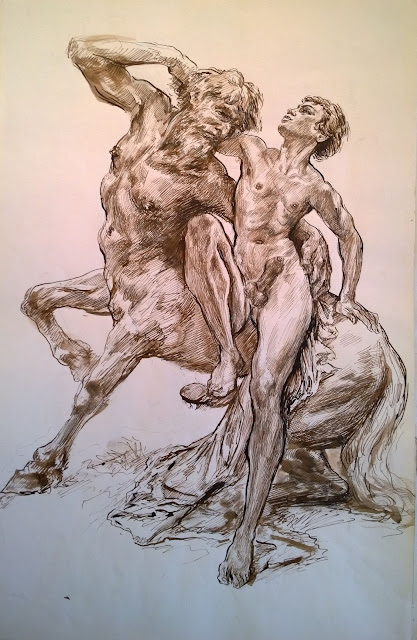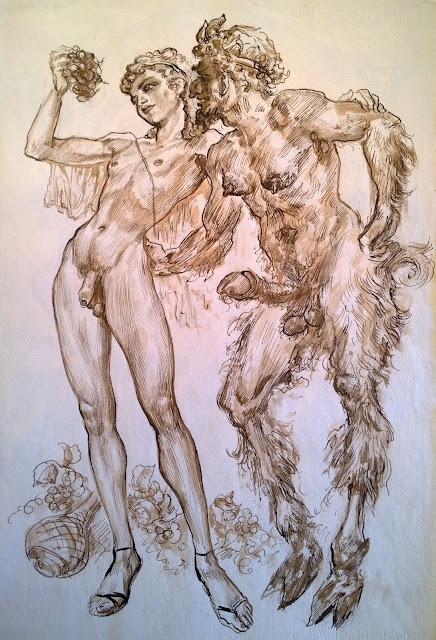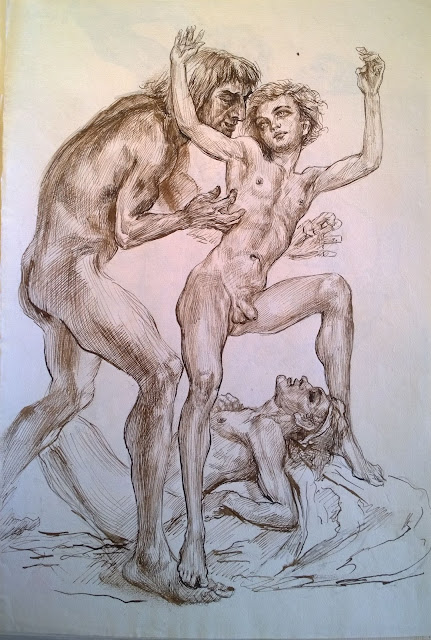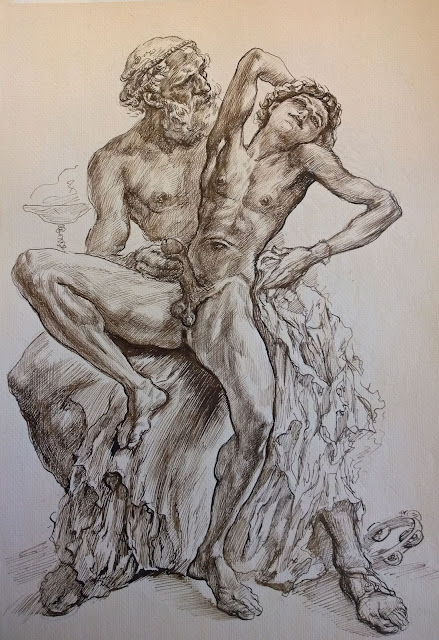SEX WITH MEN: AN IMPOSSIBLE LOVE?
BY EDWARD BRONGERSMA
“Sex With Men: An Impossible Love?” is part of “The Outlets”, the final section of “Boys and their Sexuality”, the third chapter of Loving Boys, the encyclopaedic study of Greek love by the eminent Dutch lawyer, Edward Brongersma, of which the first volume (including this) was published by Global Academic Publishers in New York in 1986.
Since Brongersma mentions the drawings of the German (later Swedish) artist Ernst Georg Hildebrand (1906-91) in his book Au plaisir des dieux: dessins germaniques 1940-1958 (published by French Art in Paris in 1978) as illustrating his main point in this chapter, four of those drawings are used here to illustrate it.

As can be expected, most homosexual activities of pre-pubertal boys take place with their own age-mates. This is also often the case with boys going through puberty.[1] Nevertheless, not a few boys prefer an adult partner. In his fine novel Antinous, Geliebter, Ulrich Stöwer has the philosopher Epictetus make this sad commentary about love between boy and man to Emperor Hadrian, “Usually it is the youthful body, the guileless laugh, the open-mindedness, the handsome face, the fresh skin which the man loves… As long as he is young himself he will easily find a friend who also desires and loves him. But, while his special attraction to youth persists, the man grows older, and now the potential for a profitable, that is to say equivalent, friendship, diminishes more and more, his successes becoming increasingly rare. For the vanishing appeal of youth he must substitute remedies and devices: the arts of the hairdresser, bath-superintendent, masseur; by pretense, persuasion, seduction; by exciting youthful curiosity; even by violence – and only exceptionally by the superiority of his mind. But none of these can restore what is most important: the radiant, vital, attractive body. The relationship between man and boy becomes the more equivocal and fragile the more they differ in age and the longer the bond between them has existed. Each has to resort to new forms of mutual deception, and even their brief moments of shared lust cannot dispel the painful certainty that one day soon they will have to separate.”[2]

Plato, in his belief that love is based upon the veneration of beauty, similarly denied that the boy can love the man, because the man was ugly.[3] He could have learned better from Anakreon who, in one of his poems, has a boy, flinging himself into the arms of his lover, cry out, “He is a greybeard but beautiful, really beautiful, and he loves to enjoy himself in bed!”[4]
Is it really beauty that a boy is looking for in a partner? Peter Schult, drawing upon his rich experience, says it isn’t. “Children simply don’t have this aesthetic judgement about bodily beauty. It’s always a source of wonder for me, because I myself have a kind of horror of my body, suffering as I do from the advance of wrinkles, the development of middle-age spread. So I am always frightened of losing my partners, the youngsters, because of this. But although they may sometimes say something like, ‘Oh, man, what a paunch you’ve got!’, I’ve nearly never seen in children of twelve to fifteen this fear of ugliness or old age or experienced rejection because of it. They see the personality rather than the body or the beauty of the body.”[5] What they do expect from the adult partner is pleasure[6] – and more: in 1979, on a program of the Dutch evangelical broadcasting system “Ikon”, a fourteen-year-old was interviewed about his sexual relationship with Jan, an adult man. The interviewer asked at one point, “What is there in Jan that is so attractive to you? Do you find him handsome?” The boy appeared confused by the question – it seemed that the idea had never occurred to him. After a moment he replied, “No, but with him I feel safe, protected.”

Aesthetic feelings about physical attraction develop in boys only in a later stage. Only then is the ageing boy-lover faced with the dilemma of the Greek poet Dinos Christianopolous of whether to leave the light on or off as he makes love:
i don’t know which I prefer –
in the darkness my ugliness disappears
in the light your beauty glows.[7]
With younger boys it doesn’t matter.
131 Nineteen-year-old Albert declares, “When you’re very young your sexuality isn’t yet differentiated. You’re not attracted by just one type of gay person. I remember that if they’d presented me with forty different people when I was ten I’d have been willing to sleep with every one of them no matter who…[8]
In homophiles there is often a nearly pathological fear of growing old.[9] “For ‘normal’ gays, however, there are no common remedies to conquer with bravura the inevitable barricades of getting old. But the pederast, whose sexual impulses are exclusively concentrated on half-grown boys, is paradoxically safe from this fear of old age: scientific research has proved that for 12- to 15-year-old boys having sexual relationships with an adult man the exterior of the partner is not of any importance. The older partner is idealised by the boy for his knowledge, for his professional status, his car, his wallet or – very frequently – for his human understanding. The symptoms of old age or flaws like baldness are only very rarely thought troublesome by pubertal bedfellows. A fifty-two-year-old boy-lover said, ‘My whole life through I only slept with heterosexual boys between 13 and 16 years of age. For them I’m friend, father and lover united in one person. And for me they have the same honest (eventually dishonest) feelings, regardless of whether I’m an 18-year-old Apollo or an 80-year-old fairy king.’ ”[10]

It can even happen that a boy is fascinated by a man’s ugliness. This is the theme, for example, of Peyrefitte’s novel Roy[11] and of Isabel Holland’s novel The Man Without a Face.[12] The German artist Hildebrandt (Au plaisir des dieux) draws with evident relish scenes of beautiful, slender adolescents being chased by ugly, satyr-like old men, to whom they willingly abandon themselves.
In his research among 2500 male subjects, Barrington[13] even found “a large percentage (perhaps as high as 12% or more) of bisexual and homosexual youth and young men who prefer sexual contacts with older men, 50 to 65+.”
Sigmund Freud stressed the fact that the first sexual object of the child’s desire is an adult and not an age-mate.[14]. The beloved adult is generally, of course, the mother or the father. However, as the child grows and becomes more and more perceptive of his surroundings, he is faced with two contradictory commands: Love your parents! Don’t desire incest! Faced with such a dilemma, the child develops feelings of guilt toward the parents, for whom this is quite a satisfactory development, for it makes their son meek and submissive.
But now, suddenly, a boy-lover crosses his path, and both are touched by Eros, In the eyes of the boy this man is an adult: that is, he belongs to the undifferentiated category of people over 25 years of age. Thus he is similar to his father and can therefore be a kind of substitute – but a substitute with whom sexual love is possible without committing incest. The boy-lover, then, offers a solution to his inner conflict.
Continue to Sex With Men: The Parents
[1] Reiss Jr., A. J., Sex Offenses: the Marginal Status of the Adolescent, in: Gagnon & Simon (Eds.), Sexual Deviance. New York: Harper & Row, 1967, p. 66 [Author’s reference].
[2] Stöwer, U., Antinous, Geliebter! München: List, 1967, 237. [Author’s reference]
[3] Buffière, F., Eros adolescent–La pédérastie dans la Grèce antique. Paris: Les Belles Lettres, 1980, 402 [Author’s reference].
This misrepresents Plato through typically modern misassumptions. Buffière, speaking generally of Plato and Xenophon as representatives of Sokrates’s thinking, asked rhetorically if “a boy in the flower of his youth could love a man withered by age.” Plato himself simply assumed that a boy could not feel eros for any man, without regard to his age (hence there is no excuse for Brongersma saying that what Plato said was similar to what he himself claims Epictetus expressed – the obstacle for the boy in Greek thinking was the man’s being a man, rather than his being old or ugly). On the other hand, in his Phaidros (255), Plato made clear that a boy could feel anteros, reflected or counter-love, for his lover. [Website note]
[4] Peyrefitte, R., Les conquêtes d’Alexandre, Paris: Albin Michel, 1979, p. 145 [Author’s reference].
Can anyone provide a primary source for this improbable alleged statement by Anakreon? It is ridiculous of Brongersma to cite a modern novel as if it were a substitute for an authoritative source. [Website note]
[5] Schult, P., Gefallene Engel. Berlin: Gmünder, 1982, 105 [Author’s reference].
[6] Nichols 1971, 15 [Author’s reference, which does not correspond to anything listed in his bibliography].
[7] translation: Kimon Friar, Gay Sunshine Journal 47: 173, 1982 [Author’s reference].
[8] Max, Truc, Albert & Jérôme, Die Pädophilie. In: Dieckmann & Pescatore (Eds.) Drie Milliarden Perverse. Berlin: Rosa Winkel, 1980, 71, 76. [Author’s reference]
[9] Baudry, A., La condition des homosexuels. Toulouse: Privat, 1982, 78. [Author’s reference]
[10] Ziegler, A., Homosexualität, Hannover: Leine, p. 11 [Author’s reference].
[11] Peyrefitte, R., Roy. Paris: Albin Michel, 1979, [Author’s reference]
[12] Holland, I., The Man Without a Face. New York: Bantam Books, 1972, [Author’s reference]
[13] Barrington, J. S., Sexual Alternatives for Men. London: Alternative Publishing, 1981, 180. [Author’s reference]
[14] Schérer 1979, 92 [Author’s reference, but is not clear which is meant of two books by Schérer published in 1979].

Comments powered by CComment